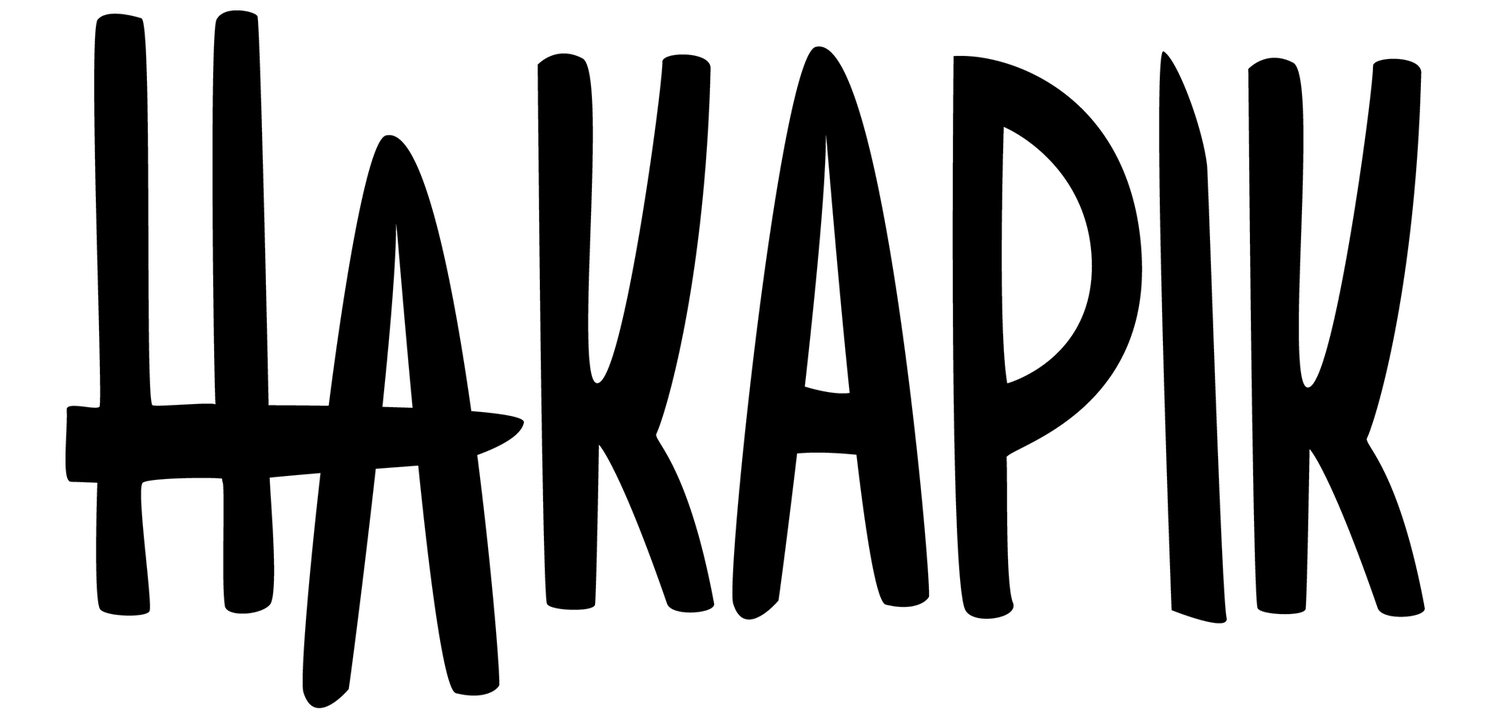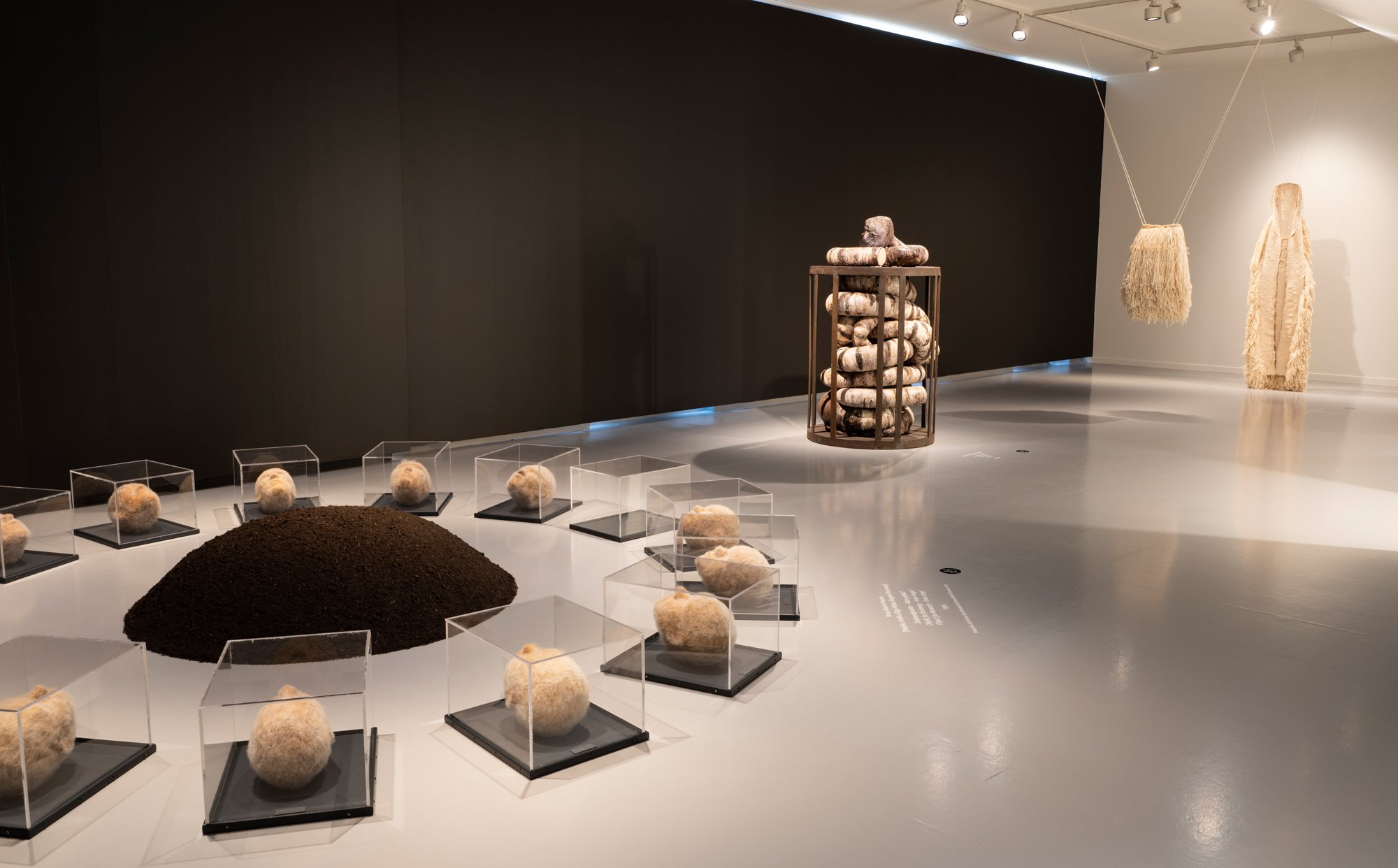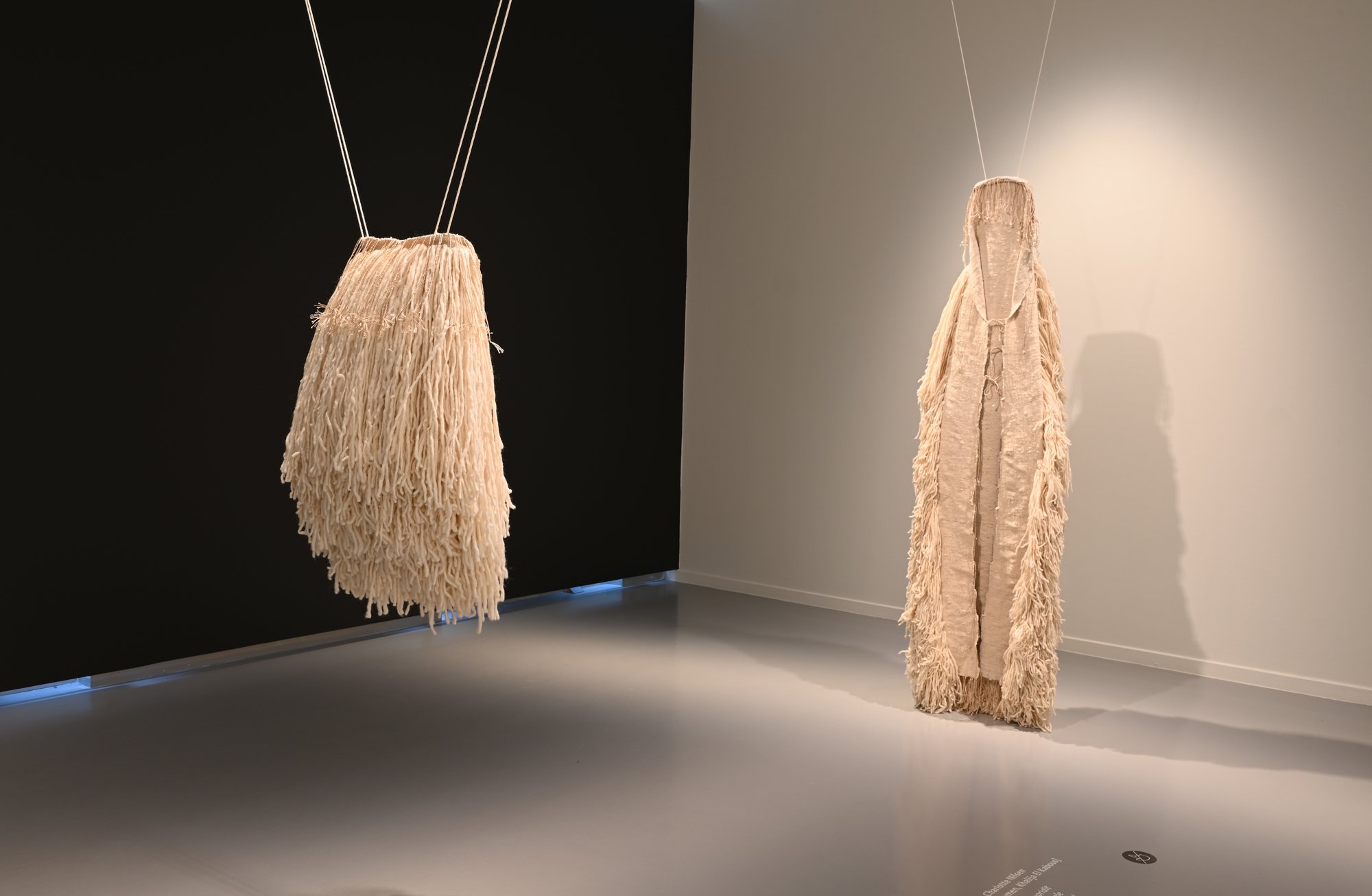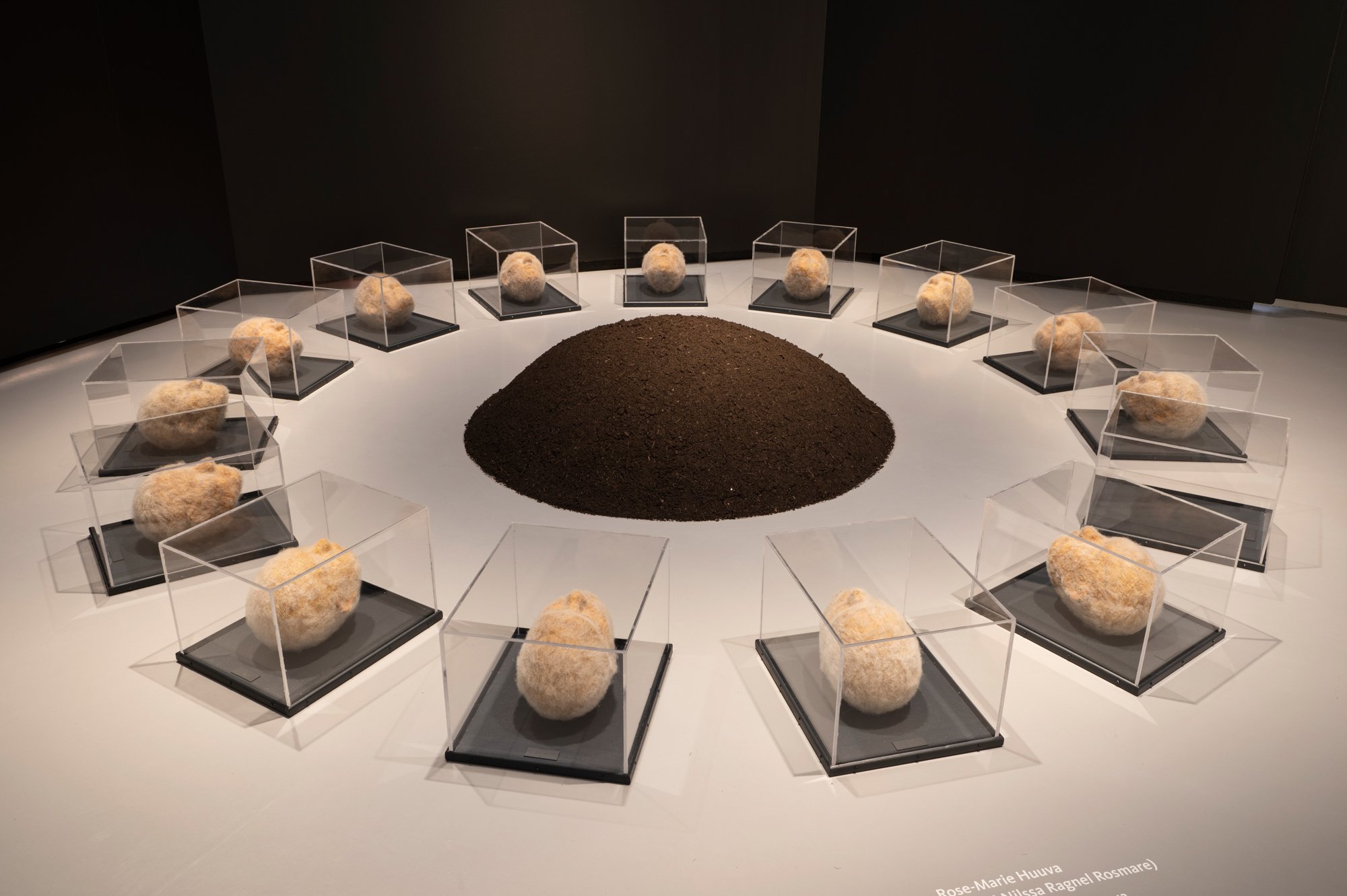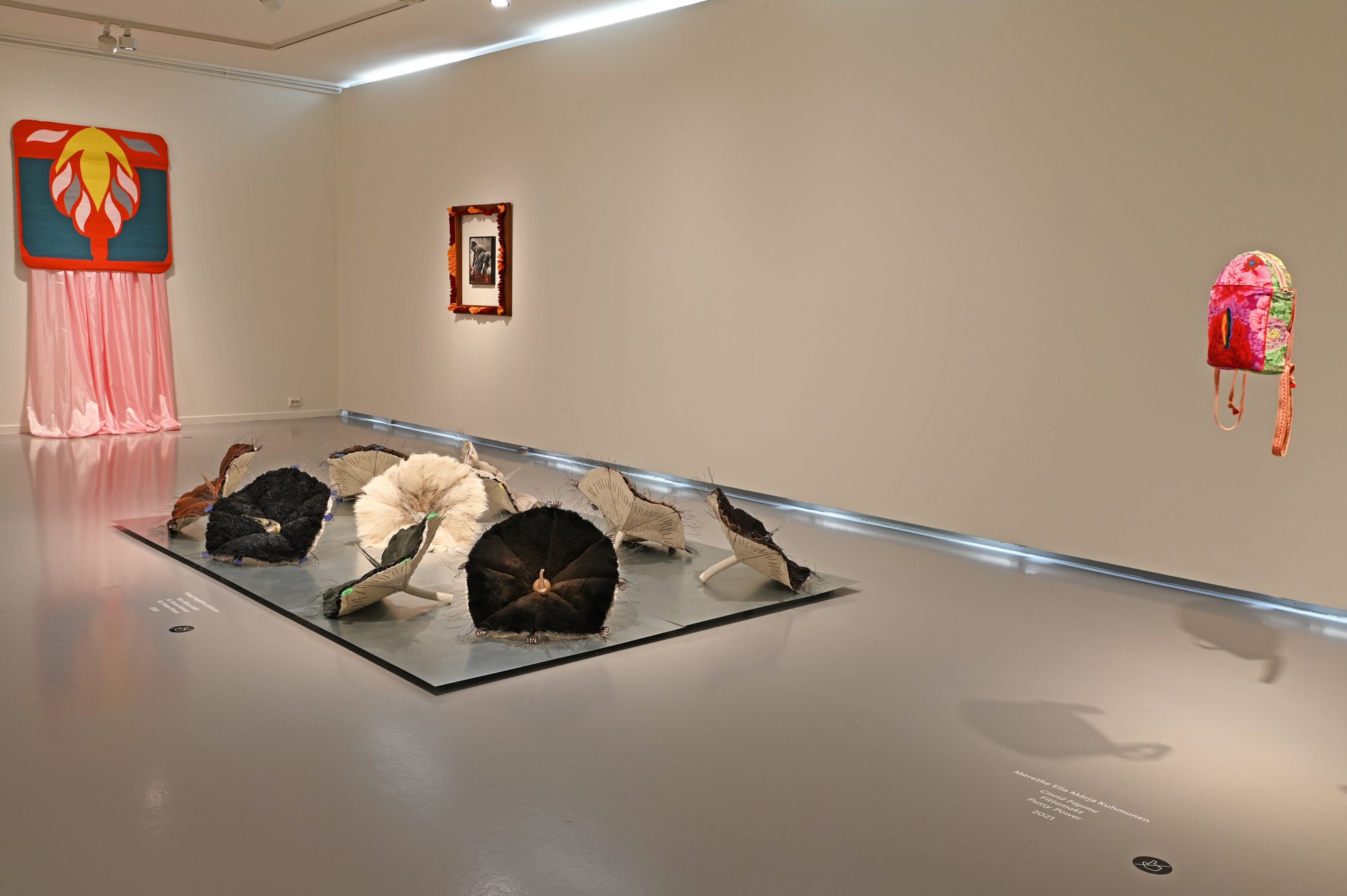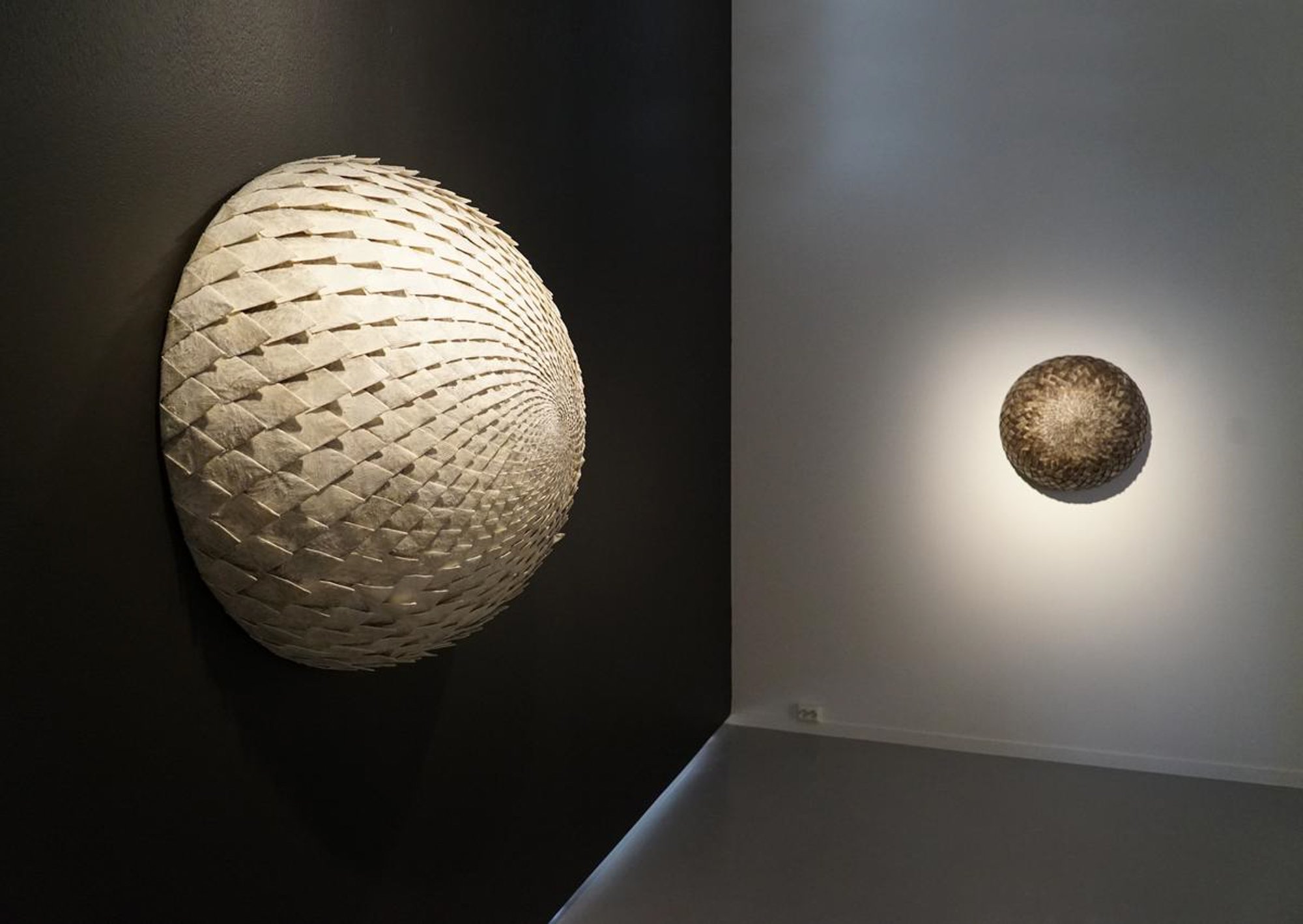Tapping into the power of Gába: a mixed experience
Review of the exhibition Gába – female resilience (Gába - kvinnelig skaperkraft) at Nordnorsk Kunstmuseum, 18.03.2024 - 28.04.2024, Tromsø
There is something akin to a hesitation that holds back the power of Gába.
A highly skilled, knowledgeable, independent, resilient woman: that is a Gába, in northern Sámi, the catalog informs me. From Sápmi and northern Norway, all the artists exhibited are contemporary women who show great craftsmanship – as all artworks are material based. The exhibition is divided into three thematic rooms: Sorrow, Female Empowerment and Our Ocean.
Shared sorrow is halved sorrow
The room Sorrow places strength and vulnerability side by side, in a deeply touching display of the pain that life brings, and the courage to try to heal wounds –and to share one’s story.
Charlotte Nilsen’s work, To Heal (2020) is a two-part tapestry of woven wool yarn, made in collaboration with Berber elderly weavers Zaina Amoumen and Khalija El Kabous.
This is a story of grief and of finding solace in unexpected places. Nilsen ended up in the village of Assersif in 2019, after losing her teenage son. There a young boy gifted her wool from locally grazing sheep, and Nilsen was shown an old loom made of Argan tree branches and traditional wool-woven carpets. The two elders weaved while the grieving artist created the pattern, resulting in two delicate and heavy garments: one that looks like a Berber coat with a hood, the other, an elaborate top or small dress that looks like it could fit a child. In the exhibition, the two pieces are suspended by invisible threads from the ceiling, facing one another, as if absorbed in silent conversation.
These faceless characters – ghosts, almost – remind of the absents: those we have lost but we carry with us, sometimes secretly talking to them in the deep of our hearts. The sturdiness and heaviness of the wool threads, combined with the subtlety of the weaving and beauty of the pieces felt acutely moving.
The softness of the wool is both in material contrast and in echo with the other artworks in that same room: Annelise Josefsen’s Stuck (2016) is all about perceived hardness, with its twisted birch-imitating sculpture that is in fact made of Styrofoam; Inger Blix Kvammen’s The Dream Carrier Vika, Brigade No. 5, Cape Kanin, Russia (2008) is hard, sharp silver wire and barbed wire, but opens up to softness and pain in the form of photographs of Nenet girls and women; while the wool of Nilsen’s piece finds a friend in Rose-Marie Huuva’s remarkable installation, Object for Research – How long? (1999)
The latter is one of seven iconic pieces that Huuva donated to the Nordnorsk Kunstmuseum in 2017. It showcases fifteen plexiglass boxes that make up a circle, each filled with a featureless head, except for the fifteenth one, which is empty. The work is both an evocation of Sámi myth and a comment on the remnants of colonization. The legend is about fifteen Sámi chiefs, who all got murdered by colons coming from the South, save for one, who managed to escape North. This is evoked in Huuva’s work through the empty box that also points to the North. The piece goes beyond the legend: it denounces the non-consensual excavation of Sámi remains which has been practiced throughout the 19th and 20th century by colonial scientists trying to prove their theory of race.
The soft-looking, wooly heads look eerily at the audience, without eyes but with barely-defined features, they seem to imbue the room with their ghostly presence. And yet they are restrained, locked in plexiglass cases: a stark reminder of the cold and oppressive colonial power that claimed their lives –and tried to destroy a culture and a way of relating to the world around them. However, colonialism’s destructive grip failed to stifle Sámi voices, as both the chief who escaped and Huuva herself remind us.The artist herself has been actively involved in petitioning the Swedish government to repatriate the ancestors’ remains that had been exhumed at the Ruonala graveyard in 1915.
Between grief and rebirth, hardiness and suppleness, the works that form this room create a powerful chorus of voices that subtly echo and reinforce one another.
A superficial curatorial approach to female empowerment and resilience
Walking into the next room with this vulnerable feeling still warm in my chest, a sense of disappointment washes over me. The cream-colored-walls and the gray floor of the room entitled Female Empowerment, form a dull background to individually interesting, but collectively disparate works. All the works are arranged in a kind of line that follows the direction of the room, towards the right wall. It is possible to circle around the two pieces by Merethe Ella Márjá Kuhmunen and Aslaug Magdalena Juliussen, but the placement of the other works gives a sense of a corridor on the left-hand side of the room, linking the two other rooms together.
The exquisitely made, queer Pussy Power (2021) backpack created by Kuhmunen hangs a bit lonely at the end of a transparent nylon thread, close to the overwhelming forest of Juliussen’s giant Re: Frozen Flowers (2009) made from repurposed materials such as reindeer antler, vintage fur, leather clothing and glass. At the end of the room, another colorful, but somewhat out of place textile portal Luoittášin du sisa (I Would Probably Let You In) (2016) created by Linn Rebekka Åmo does not help make much sense of the room. I leave the room wondering how these four particular artworks, which also include Raisa Porsanger’s Inclusion Through Exposure (2021), really define “Female Empowerment” more than any other room.
There is already a flaw in that title: “Empowerment” would have sufficed, knowing that the exhibition is centered on female artists. The qualificative makes it almost weaker, as if empowerment has a gender, instead of belonging to those who have courage: courage to rise beyond the oppression and limitations placed upon them, determination to show their skills and to live from their craft, passion to speak their truth and not be reduced to society’s narratives. In addition to that, resilience is a disputed quality: on the one hand, it is the now popularized notion that (mostly oppressed) people have devised strategies, honed skills, and built qualities to survive in the face of adversity, to preserve their dignity and stories; to survive.
On the other hand, less-often heard criticism of the contemporary Western use of “resilience” points out a certain glorification of survival as a symbol of power, therefore reducing those who did not “make it” to less strong. But is what doesn’t kill us always making us stronger? It makes us alive, survivors, but sometimes shadows of one selves. Were those who were not resilient enough to continue living through abuse, trauma, dehumanization, actually weaker, or simply not wanting to give up their bodies and minds to violence –another form of resistance?
These questions remain in the air in the exhibition, leaving me feeling that this collection of outstanding works had potential to go much further with a more in-depth, coherent presentation and communication.
Perfect spheres of resilience
Nonetheless, the last dive into the artworks of the Ocean-themed rooms is a convincing finish to the exhibition. Standing out are two of Solveig Ovanger’s Hemispheres (I and II, 2012 and 2015). These large, almost alien-looking half-spheres are made of pollock skin. The artist uses a skin-tanning knowledge handed to her by Indigenous people of Eastern Siberia, to make the fish skin pliable and preserved without the use of chemicals. The spheres themselves are assembled with small pieces of the fish skin using the Fibonacci sequence: a perfect order that is also found in the Universe. The result is two eerie fish planets that invite us to contemplation, reminding us of the two sides of the moon –one dark, one light.
The ocean, the fish, the Indigenous knowledge, the artist: a sequence of giving and taking, all contributing to their part in a circular movement that has no end and no beginning. Like the spheres, each piece in its place, distinct and necessary. This is a remarkable visual rendering of resilience in its all-encompassing sense, far from the self-help, Instagram-philosophy rendering of the term. When resilience is to find one’s gift, to receive it and to keep giving it back. The ocean is where we come from and has been the great provider to many Indigenous peoples’ livelihood. Even for us living in cities, some far from the direct reach of the Sea, the ocean influences our lives directly: it regulates heat and moisture throughout the planet, and it absorbs a great deal of the CO2 emissions –not to mention hosting more than 70% of all animal life on Earth.
All in all, the exhibition Gába shines through individual examples of Gába at its finest, and the dialogue between artworks in the room Sorrow feels like a balm to the wounds of existence. But while the art works presented are impressive, the overall exhibition design does not always reflect the exhibition’s formidable content. It could probably have benefitted from a more thorough, articulate curating around the theme; and in order to do that, why not having filled the whole museum with Gába power, instead of the last floor only?




